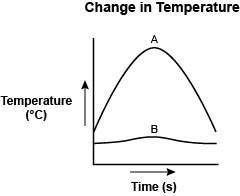
Chemistry, 14.12.2020 20:40 Hockeypro1127
In an experiment, equal amounts of water and soil were first heated and then left to cool. The graph shows the change in temperature for each with time.
A graph with the title Change in Temperature is shown. The y axis title is Temperature in degree C and the x axis title is Time in seconds. An inverted U shaped curve labeled A is plotted. A flatter curved line labeled B is also shown plotted on the graph.
Which statement about the curves A and B is true?
Curve A represents how soil takes longer to heat and longer to cool.
Curve B represents how water takes longer to heat and longer to cool.
Curve A represents water as it heats rapidly and cools slowly.
Curve B represents soil as it heats slowly and cools rapidly.
If you don't understand, here's the image.


Answers: 1
Another question on Chemistry

Chemistry, 21.06.2019 23:00
Write a brief passage describing a neutral atom of nitrogen-14 (n-14). describe the number of protons, neutrons, and electrons in the atom, where each type of particle is located, and how the terms atomic number, mass number, and atomic mass are related to the particles. use the periodic table to you. 14 protons and eletrons since its a neutral atom
Answers: 1

Chemistry, 22.06.2019 04:20
Which of the following is true for the actual yield of a reaction? it is always calculated as a ratio. it is the yield from the excess reactant. it is the yield from the limiting reactant. it is always less than the theoretical yield.
Answers: 1

Chemistry, 22.06.2019 08:30
If i initially have a gas at a pressure of 12 atm, a volume of 23 liters, and a temperature of 200 k, and then i raise the pressure to 14 atm and increase the temperature to 300 k, what is the new volume of the gas?
Answers: 2

Chemistry, 22.06.2019 14:50
Consider the following multistep reaction: a b→ab(slow) a ab→a2b(fast)−−−−−−−−−−−−−−−−− 2a b→a2b(overall) based on this mechanism, determine the rate law for the overall reaction. express your answer in standard masteringchemistry format. for example, if the rate law is k[a]3[b]2 type k*[a]^3*[b]^2
Answers: 3
You know the right answer?
In an experiment, equal amounts of water and soil were first heated and then left to cool. The graph...
Questions

Health, 13.10.2019 01:00


English, 13.10.2019 01:00

Social Studies, 13.10.2019 01:00

Biology, 13.10.2019 01:00


History, 13.10.2019 01:00


Computers and Technology, 13.10.2019 01:00


History, 13.10.2019 01:00


English, 13.10.2019 01:00

Biology, 13.10.2019 01:00

Mathematics, 13.10.2019 01:00


Geography, 13.10.2019 01:00

Social Studies, 13.10.2019 01:00

Physics, 13.10.2019 01:00

Mathematics, 13.10.2019 01:00



